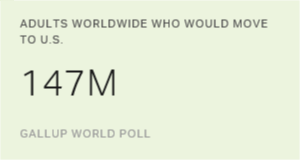WASHINGTON, D.C. -- A median of nearly two-thirds of adults (65%) across 133 countries and areas Gallup surveyed in 2011 say the media in their countries have a lot of freedom, essentially unchanged from the median of 67% found in 2010. These views still vary worldwide, ranging from a low of 23% in Belarus to a high of 97% in Finland.
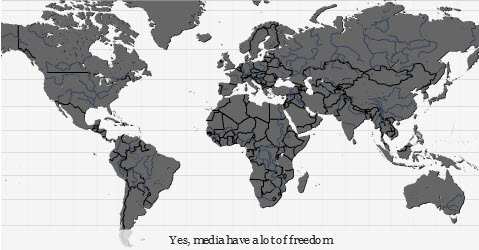
The countries where perceived media freedom is lowest span multiple regions, including the Middle East, sub-Saharan Africa, and former Soviet Union countries. Fewer than 4 in 10 adults in 11 countries, including Gabon, Armenia, Palestinian Territories, and Iraq, say their media have a lot of freedom -- despite legal or constitutional provisions that guarantee freedom of the press or speech in most of these countries. Independent media evaluators, such as Freedom House and Reporters Without Borders, also rate these 11 countries poorly on their freedom of the press indicators.
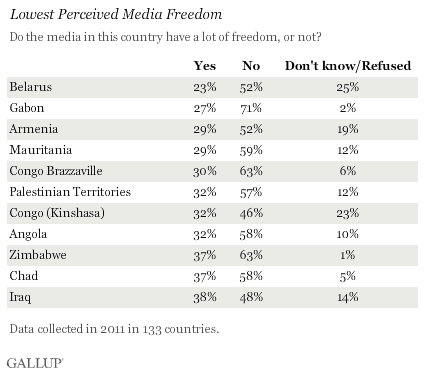
With a few exceptions, perceived media freedom is highest in developed countries in Asia, Europe, and North America. Ghana is the sole representative of sub-Saharan Africa in the list of countries worldwide where roughly 9 in 10 or more adults say their media have a lot of freedom. Freedom House recognizes the press in Ghana as among the most free in Africa.
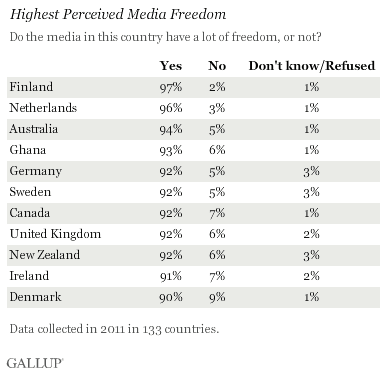
People's Perceptions Generally Match Experts' Assessments
People's perceptions about the amount of freedom their media have typically align with expert assessments, such as those from Freedom House. Freedom House assesses the political, legal, and economic environments of each country and evaluates the extent to which the countries promote or restrict their media. Freedom House rates each country in these three categories and assigns it a value, with the higher numbers indicating less freedom. Freedom House then uses these scores to rate each country's media as "free," "partly free," or "not free." Resident perceptions of media freedom using Gallup data highly correlate with Freedom House scores.
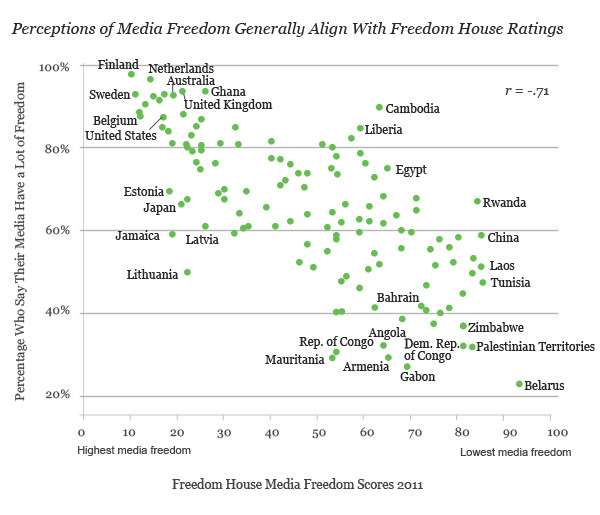
However, opinions in several countries indicate that people perceive a level of media freedom that is higher than independent, external evaluations would suggest. For example, in Botswana, Cambodia, Hong Kong, Indonesia, Kuwait, and Liberia, 80% or more of residents report to Gallup that their media are free; however, Freedom House does not classify the media in any of these countries as "free."
Implications
Traditional measures of media freedom have relied heavily on external assessments. While these evaluations are highly informative, the perceptions of people living in these countries are important for policymakers to consider in the ongoing discussion about freedom of the press. Gallup's ongoing worldwide survey research also enables tracking of how these perceptions are changing over time.
Lee Becker is a Gallup senior research adviser and director of the James M. Cox, Jr., Center for International Mass Communication Training and Research at the University of Georgia.
Tudor Vlad contributed to this article. Vlad is a Gallup senior research adviser and associate director of the James M. Cox, Jr., Center for International Mass Communication Training and Research at the University of Georgia.
For complete data sets or custom research from the more than 150 countries Gallup continually surveys, please contact SocialandEconomicAnalysis@gallup.com or call (202)715-3030.
Survey Methods
Results are based on telephone and face-to-face interviews with approximately 1,000 adults, aged 15 and older, conducted in 133 countries between February and December 2011. For results based on the total sample of national adults, one can say with 95% confidence that the maximum margin of sampling error ranged from ±2.2 to ±5.1. The margin of error reflects the influence of data weighting. In addition to sampling error, question wording and practical difficulties in conducting surveys can introduce error or bias into the findings of public opinion polls.
For more complete methodology and specific survey dates, please review Gallup's Country Data Set details.


